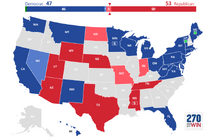The United States Senate elections of 2018 was held on November 6, 2018 along with gubernatorial elections, house elections and other midterm elections.
Republicans campaigned on the improving economy and stricter immigration laws and Democrats campaigned on Russian Interference, Gun Control, Open Borders and Women and Minority rights.
In the senate, the Republican Party keep their majority and gained 3 senate seats, while the democratic party gained 1 seat. Republicans gained Missouri, North Dakota and Indiana with Josh Hawley, Kevin Cramer, Mike Braun respectively and Democrats gained Nevada with Jacky Rosen. Close senate races include Arizona (won by Martha McSally), Florida (won by Incumbent Bill Nelson), and Montana (won by Incumbent Jon Tester).
On December 19, 2018, Democratic party officials said that the Russian government interfered with the 2018 Midterms, Republican Party officials and President Donald Trump said it was a hoax made up by the Democratic Party.
Results[]
Special Elections[]
Two Special Elections occurred since Senator Al Franken had sexual allegations in 2017 and Senator Thad Cochran retired due to age in April 2018.
| State | Senator | Result |
|---|---|---|
| Minnesota | Tina Smith (D) | Incumbent won, Democratic Hold |
| Mississippi | Cindy Hyde-Smith (R) | Incumbent won, Republican Hold |
Elections leading up to the next congress[]
Maps[]

